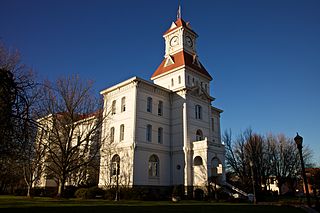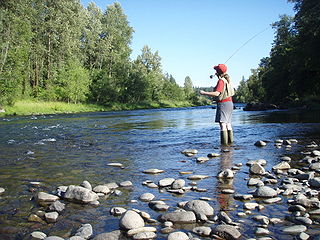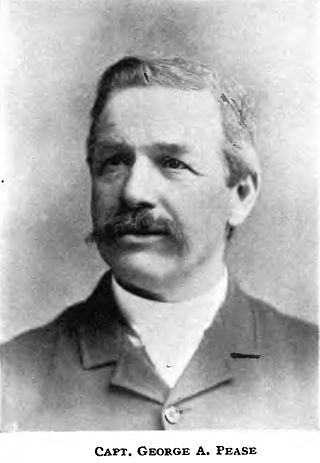Related Research Articles

Corvallis is a city in and the county seat of Benton County in central western Oregon, United States. It is the principal city of the Corvallis, Oregon Metropolitan Statistical Area, which encompasses all of Benton County. As of the 2023 Census Population Estimates, the population was 61,087, making it the 9th most populous city in Oregon. This does include the 38,000 Oregon State University students attending classes in Corvallis, over 5,250 of which live in one of 16 residence halls on the main campus. Corvallis is the location of Oregon State University 420-acre main campus, Samaritan Health Services, a top 10 largest non-profit employer in the state, a 84-acre Good Samaritan Regional Medical Center campus, and a 2.2 million square foot, 197-acre Hewlett Packard research and development campus that invented the Laser jet printer and the Computer mouse. Corvallis is a part of the Silicon Forest Corvallis is the westernmost city in the contiguous 48 states with a population larger than 50,000.

The Willamette River is a major tributary of the Columbia River, accounting for 12 to 15 percent of the Columbia's flow. The Willamette's main stem is 187 miles (301 km) long, lying entirely in northwestern Oregon in the United States. Flowing northward between the Oregon Coast Range and the Cascade Range, the river and its tributaries form the Willamette Valley, a basin that contains two-thirds of Oregon's population, including the state capital, Salem, and the state's largest city, Portland, which surrounds the Willamette's mouth at the Columbia.

Linn County is one of the 36 counties in the U.S. state of Oregon. As of the 2023 census population estimates, the population was 131,496. The county seat is Albany. The county is named in the honor of Lewis F. Linn, a U.S. Senator from Missouri who advocated the American settlement of the Oregon Country. Linn County comprises the Albany, OR Metropolitan Statistical Area, which is included in the Portland-Vancouver-Salem, OR-WA Combined Statistical Area. It is located in the Willamette Valley. In 2010, the center of population of Oregon was located in Linn County, near the city of Lyons.

West Linn is a city in Clackamas County, Oregon, United States. A southern suburb within the Portland metropolitan area, West Linn developed on the site of the former Linn City, which was named after U.S. Senator Lewis F. Linn of Ste. Genevieve, Missouri, who had advocated the American occupation of the Oregon territory as a counterclaim to the British.

Marys River is a 40-mile (64 km) tributary of the Willamette River in the U.S. state of Oregon. From its source at the confluence of its east and west forks near Summit, it flows generally southeast from the Central Oregon Coast Range to Corvallis.

Champoeg is a former town in the U.S. state of Oregon. Now a ghost town, it was an important settlement in the Willamette Valley in the early 1840s. Located halfway between Oregon City and Salem, it was the site of the first provisional government of the Oregon Country.

The South Santiam River is a tributary of the Santiam River, about 69 miles (111 km) long, in western Oregon in the United States. It drains an area of the Cascade Range into the Willamette Valley east of Corvallis.

Oregon's 4th congressional district represents the southern half of Oregon's coastal counties, including Coos, Curry, Lincoln, Lane, and Benton counties, alongside the northwestern half of Douglas County and a sliver of Linn County. It is centered around the state's two college towns, Eugene and Corvallis, homes to the University of Oregon and Oregon State University, respectively. Politically, the district leans slightly Democratic, due to the presence of Lane and Benton counties, home to over half the district's population. Lincoln County also tilts Democratic. Contrariwise, Douglas County is heavily Republican, as are to a lesser extent Coos and Curry. The district has been represented by Democrat Val Hoyle since 2023.

Ellendale is a ghost town in Polk County, Oregon, United States, about two and a half miles west of Dallas. It was the first settlement in present-day Polk County by non-Kalapuyans. The community's name changed over the years, with the first post office in Polk County being opened in this locality as "O'Neils Mills" in 1850. The post office was renamed "Nesmiths" in 1850 and discontinued in 1852. The community was eventually renamed Ellendale.
Historic ferries in Oregon are water transport ferries that operated in Oregon Country, Oregon Territory, and the state of Oregon, United States. These ferries allowed people to cross bodies of water, mainly rivers such as the Willamette in the Willamette Valley, and the Columbia, in order to transport goods, move people, and further communications until permanent bridges were built to allow faster crossing of the water. The early ferries were used by wagons and pedestrians, while later ones transported trains and then automobiles. Oregon has a few automobile ferries still in operation.
Buena Vista is an unincorporated community in Polk County, Oregon, United States. It is located on the Willamette River, and is the western landing for the Buena Vista Ferry. It is approximately 7 miles (11 km) south-southeast of Independence.

Gazelle was an early sidewheeler on the Willamette River in what is now the U.S. state of Oregon. She did not operate long, suffering a catastrophic boiler explosion on April 8, 1854, less than a month after her trial voyage. This was the worst such explosion ever to occur in the Pacific Northwest states. The wrecked Gazelle was rebuilt and operated for a few years, first briefly as the unpowered barge Sarah Hoyt and then, with boilers installed, as the steamer Señorita. A victim of the explosion was D.P. Fuller, age 28, who is buried in Lone Fir Cemetery in Portland, Oregon.

The Van Buren Street Bridge was a swing span, steel motor vehicle bridge spanning the Willamette River at Corvallis in the U.S. state of Oregon. Opened in 1913, the black colored bridge was the first bridge across the river at Corvallis. Owned by the state and maintained by the Oregon Department of Transportation (ODOT), the 708-foot (216 m) long span was of a through truss design and carries one lane of traffic of Oregon Route 34 eastbound from Corvallis into neighboring Linn County.

The Willamette Valley is a 150-mile (240 km) long valley in Oregon, in the Pacific Northwest region of the United States. The Willamette River flows the entire length of the valley and is surrounded by mountains on three sides: the Cascade Range to the east, the Oregon Coast Range to the west, and the Calapooya Mountains to the south.
Burlington is an unincorporated historic community Linn County, in the U.S. state of Oregon. It was located about a mile downriver from Peoria.

James Clinton was a steamboat which operated on the upper Willamette River from 1856 to 1861. Although the Clinton was said to have been "not a very good boat.", it was the first steamer ever to reach Eugene, Oregon. James Clinton was destroyed in April 1861, when a large fire broke out at Linn City, Oregon in a shoreside structure near to where the vessel was moored.

Relief was a stern-wheel driven steamboat that operated on the Willamette River from 1858 to 1865. Relief ran for a short time on the route from Portland to Oregon City, Oregon. After being bought out by the competition, Relief was lined around Willamette Falls to the upper Willamette, where it became the first steamboat to reach Springfield. This vessel should not be confused with a later vessel, also named Relief, which operated on the Columbia and Lewis rivers from 1906 to 1931.

George Anson Pease was a steamboat captain in the Pacific Northwest region on the United States, who was active from the earliest days of steamboat navigation on the Willamette River in the 1850s. He worked in various roles until the early 1900s, commanding numerous vessels during that time. During a flood in 1861, while in command of the sternwheeler Onward, Pease rescued 40 people from a flood in the area of Salem, Oregon.
The Samaritan Health Services (SHS) is a non-profit, integrated delivery healthcare system consisting of five hospitals, over 110 physician clinics, and multiple health insurance plans in Oregon and is headquartered in Corvallis, Oregon. As of 2022 it is one of the top 10 largest non-profit employers in the State of Oregon with nearly 7,000 employees and volunteers. The Corvallis-based nonprofit was founded in 1997 when Mid-Valley Healthcare in Lebanon and Samaritan Inc. of Corvallis merged in an effort to more efficiently serve their communities. Over the years other organizations have joined Samaritan Health, such as FirstCare Health (Albany) in 1999, and the North Lincoln Health District (Lincoln City) in 2001 and Pacific Communities Health (Newport) in 2002. Samaritan Inc. began in 1948 when the Episcopal Church in Western Oregon, enabled the Corvallis General Hospital's reorganization as a not-for-profit facility.

Syracuse was a historic community in Linn County, Oregon, United States. It was located along the Santiam River, about two miles west of Jefferson. Syracuse was the first pioneer settlement in Linn County, predating Albany.
References
- 1 2 "Orleans". Linn County Cemeteries. 1940. Retrieved September 2, 2016.
- ↑ Edward Lansing Wells (1947). "Notes on the Winter of 1861–2 in the Pacific Northwest" (PDF). Northwest Science. 21: 78. Archived from the original (PDF) on June 10, 2011.
The historic town of Champoeg, where the first provisional government in Oregon was adopted, was completely destroyed, never to be rebuilt. The same was true of the town of Orleans, across the Willamette River from Corvallis.
- ↑ "Orleans Cemetery". Geographic Names Information System . United States Geological Survey, United States Department of the Interior.
44°34′12″N123°11′27″W / 44.5701°N 123.1907°W
